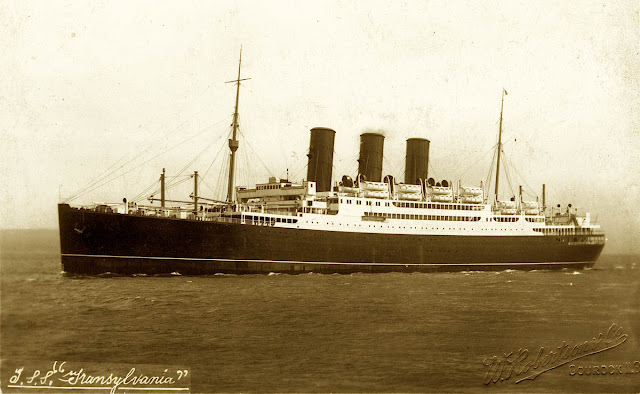Thursday 28 March 1940
 |
| Armed merchant cruiser HMS Transylvania. |
Norwegian freighter SS Burgos hits a mine and sinks 30 miles west of Skegness, England. The crew survives and is rescued by sloop HMS Pelican.
Convoy OA 119 departs from Southend, Convoy HG 24 departs from Gibraltar.
Battle of the Pacific: British warships stop Soviet ore ships Selenga and Vladimir Mayakovski and order them to Hong Kong.
Allied Air Operations: Overnight, the RAF sent reconnaissance flights over northwest Germany. Three aircraft of the New Zealand No. 75 Squadron take part in the flights for the first time. Three aircraft never return. One bomber makes a forced landing in Holland after being attacked by Dutch fighters.
Two Dornier Do 17 Luftwaffe aircraft make a sweep over the North Sea but make no successful attacks. Coastal Command intercepts them and scored hits on one, while also one RAF plane is damaged.
Allied Supreme War Council: The Supreme War Council meets for the sixth time in London. There is a new leader for the French, new Prime Minister Paul Reynaud. Reynaud's suggestions regarding attacking Soviet oil fields and shipping are rejected, though they will be "studied."
The leaders reach the same conclusion that they had in World War I, namely that neither country will conclude any armistice or other cessation of hostilities without mutual consent. They also decide to mine Norwegian territorial waters to disrupt German iron ore shipments from Sweden via Narvik (Operation Wilfred). A further plan to drop mines in the Rhine River (Operation Royal Marine) at the same time is approved pending approval by the French War Committee. Churchill, whose pet idea this Rhine operation is, says, "It will cause the utmost consternation."
The Council also make a tentative decision to send an expeditionary military force to Norway should the Germans appear to be ready to invade. The Council sets a projected date of 5 April 1940.
While an Allied landing in Norway would have been legal under the League of Nations resolutions pertaining to the Winter War, that authorization now is gone due to the Moscow Peace Treaty. An Allied invasion would be a hostile incursion on a neutral nation's territory, just as would a German invasion. Norway has given no indication that it would accept foreign troops of any nation on its soil. Churchill, though, sees an added benefit from throwing a spanner in the works: "No people are more completely upset when their plans miscarry than the Germans. They cannot improvise."
The Germans, of course, are thinking along identical lines, and their planned invasion has been set for roughly the same time. First Lord of the Admiralty Winston Churchill hopes to provoke the Germans into some rash action with the mining of Norwegian waters, thus justifying Allied "protection" of Norway and Sweden. This would cripple the German war effort, which is based upon Swedish iron ores shipped through Norway.
Propaganda: The issue of German propaganda is on everybody's mind. Churchill notes that "Reynaud spoke of the impact of German propaganda on French morale. The radio blares each night..."
British Government: The Foreign Office calls six ambassadors from southern and central Europe back to London for consultations.
US Government: Undersecretary of State Sumner Welles meets in Washington, D.C. with President Roosevelt following his discussions with European leaders.
Finland: While Finland lost territory during the Winter War in the Moscow Peace Treaty, the country is full of pride for the outstanding showing of its military against an overpowering opponent. Finnish ski soldiers march in Helsinki in a parade, complete with their reindeer.
China: In the Battle of Wuyuan, the Chinese 8th War Area continues attacking around Patzepu, Hsishantzu, Hsichiao, and Mankosu.
Holocaust: 1,600 Jewish refugees fleeing the Germans arrive in Palestine after a journey that took six months. UK troops intern them for illegal entry.
 |
| The New Zealand (No. 75) Squadron in 1942. |
March 1940
March 1, 1940: Soviet Breakthroughs Past ViipuriMarch 2, 1940: Soviets Swarm West in Finland
March 3, 1940: Soviets Across Gulf of Viipuri
March 4, 1940: USSR Apologizes to Sweden
March 5, 1940: Katyn Forest Massacre Approved
March 6, 1940: Finns Head to Moscow
March 7, 1940: The Coal Ships Affair
March 8, 1940: Peace Talks Begin in Moscow
March 9, 1940: Soviets Harden Peace Terms
March 10, 1940: Germany Draws Closer to Italy
March 11, 1940: Winter War Peace Terms Finalized
March 12, 1940: War is Over (If You Want It)
March 13, 1940: Winter War Ends
March 14, 1940: Evacuating Karelia
March 15, 1940: The Bletchley Bombe
March 16, 1940: First British Civilian Killed
March 17, 1940: Enter Dr. Todt
March 18, 1940: Mussolini To Join the War
March 19, 1940: Daladier Resigns
March 20, 1940: Soviets Occupy Hango Naval Base
March 21, 1940: Paul Reynaud Leads France
March 22, 1940: Night Fighters Arise!
March 24, 1940: French Consider Alternatives
March 25, 1940: Reynaud Proposes Action
March 26, 1940: C-46 First Flight
March 27, 1940: Himmler Authorizes Auschwitz Construction
March 28, 1940: Allies Ponder Invading Norway
March 29, 1940: Soviets Prefer Neutrality
March 30, 1940: Allied Uncertainty
March 31, 1940: The Tiger Cage
2019
No comments:
Post a Comment